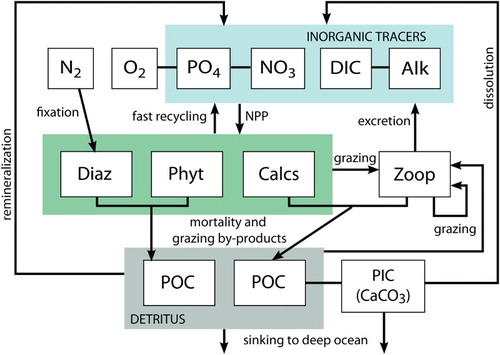Figures & data
Table 1. Miscellaneous UVic ESCM biogeochemical model parameters. Temperature-dependent parameter values are given for 0°C.
Table 2. UVic ESCM CaCO3 export-production parameters.
Table 3. UVic ESCM biogeochemical model phytoplankton production parameters. Temperature-dependent parameter values are given for 0°C.
Table 4. UVic ESCM biogeochemical model zooplankton parameters. Temperature-dependent parameter values are given for 0°C.
Table 5. Globally integrated biological properties.
Fig. 2 Averaged biogeochemical simulated tracers (CAL, solid red line; NOCAL, dashed blue line) compared with observations (black line). DIC and alkalinity observations are the standard GLODAP product (Key et al., Citation2004). Phosphate and nitrate observations are annual averages from the World Ocean Atlas (WOA; Garcia et al., Citation2009). Bottom row shows globally averaged model-data misfits.
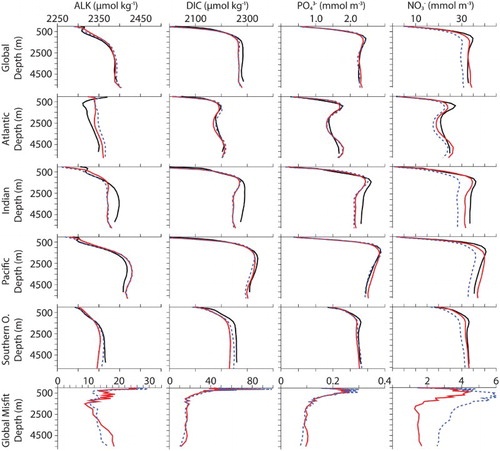
Fig. 3 Normalized Taylor diagrams of simulated tracers (CAL, red symbols; NOCAL, blue symbols) compared with observations (black circle). Observations used are as in . Ocean basins are denoted as global average (star), Atlantic (square), Indian (triangle), Pacific (plus), and Southern Ocean (diamond). The distance to the origin represents the normalized standard deviation. Normalized correlation with the observations is read from the azimuthal position. Perfect agreement with observations is a normalized standard deviation of 1 and a normalized correlation of 1.
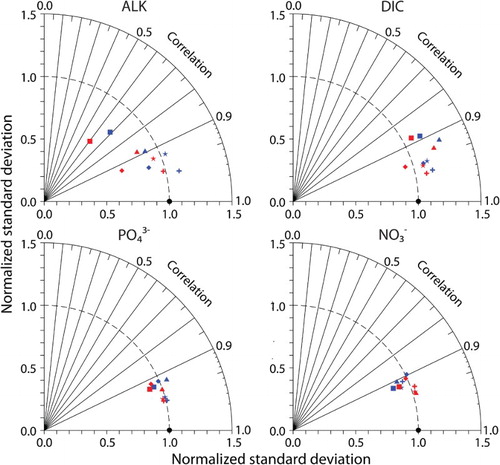
Fig. 4 Depth-integrated annual average PFT biomass (g C m−2): (a) CAL general phytoplankton; (b) CAL phytoplankton calcifiers; (c) CAL diazotrophs; (d) CAL zooplankton; (e) NOCAL general phytoplankton; (f) NOCAL diazotrophs; (g) NOCAL zooplankton. Also shown is depth-integrated NPP (g C m−2 d−1) for (h) CAL and (i) NOCAL.

Fig. 5 Zonally averaged by ocean basin and surface distributions (CAL, left column; WOA observations, right column).
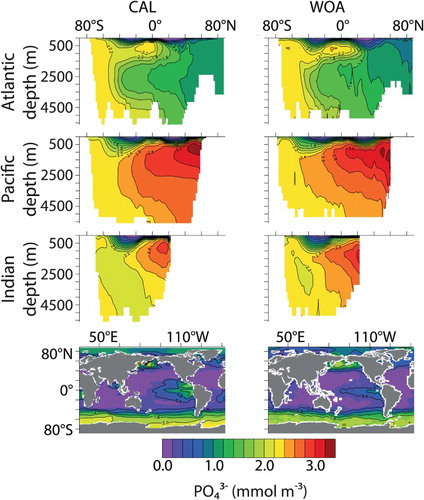
Fig. 6 Zonally averaged DIC by ocean basin and surface distributions (CAL, left column; GLODAP observations, right column).
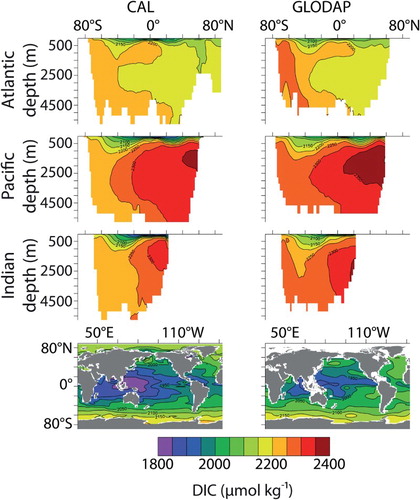
Fig. 7 Zonally averaged alkalinity by ocean basin and surface distributions (CAL, left column; GLODAP observations, right column).
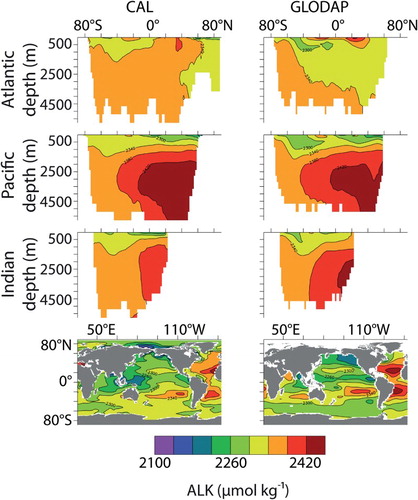
Fig. 8 Zonally averaged CaCO3 concentration by ocean basin (left and middle panels). Model CAL CaCO3 concentration, including living CaCO3 attached to phytoplankton calcifiers and zooplankton, in the surface grid box (to 50 m depth, top right panel). Bottom right is the standard CaCO3 product from Aqua MODIS, accumulated over the entire mission (2002–2013; NASA, Citation2013).
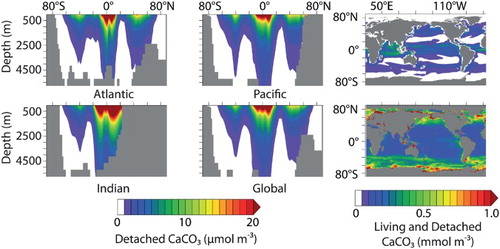
Fig. 9 Regression between modelled and observed CAL CaCO3 concentration (left panel) and CAL POC concentration (right panel) from the ocean surface to 1000 m depth. Data are in situ measurements from Lam et al. (Citation2011).

Fig. 10 Normalized Taylor diagram of model CaCO3 concentrations compared with the Lam et al. (Citation2011) dataset (black circle). Models are CAL (red circle), GFDL-ES2M (green star), MIROC-ESM (light blue circle), CNRM-CM5 (blue diamond), MPI-ESM-LR (yellow plus), and IPSL-CM5B-LR (purple circle). With the exception of CAL, the data for all models were obtained by mining the CMIP5 database (http://cmip-pcmdi.llnl.gov) using the following search terms: CMIP5/ocean biogeochem/pre-industrial control/annual output/calcite concentration.
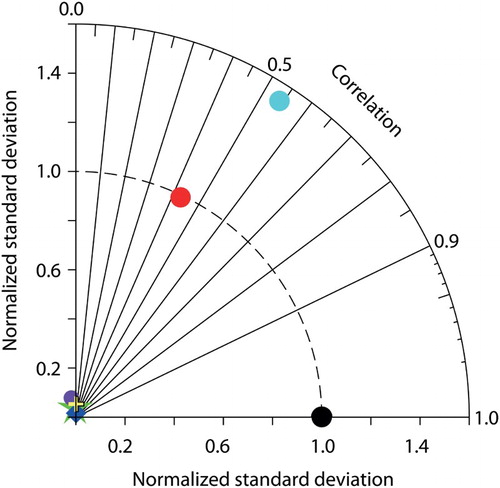
Fig. 11 Model average CaCO3 (upper left panel) and POC (upper middle panel) export and average POC:CaCO3 rain ratio (upper right panel) at 2 m depth overlaid by trap data from Honjo et al. (Citation2008). Regressions between modelled and observed values can be seen in bottom panels.
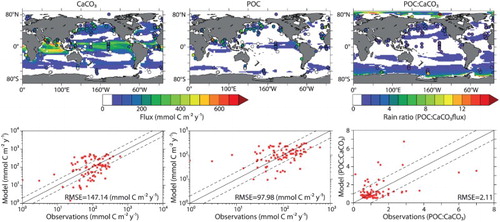
Fig. 12 Percentage CaCO3 sediment composition. CAL is shown in upper left panel; NOCAL is shown in bottom left panel, and gridded sample data from Archer (Citation1996a) is shown in top right panel.
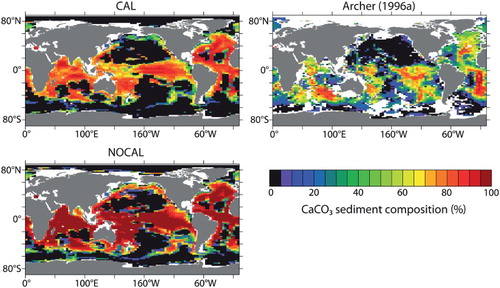
Fig. 13 Hovmöller diagrams of CAL depth-integrated PFT concentrations by latitude and month: (a) phytoplankton calcifiers, (b) general phytoplankton, (c) zooplankton. Also shown is CaCO3 flux at 130 m depth by latitude and month for (d) CAL and (e) NOCAL.


